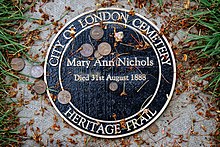
Coins for the dead is a form of respect for the dead or bereavement. The practice began in classical antiquity when people believed the dead needed coins to pay a ferryman to cross the river Styx. In modern times the practice has been observed in the United States and Canada: visitors leave coins on the gravestones of former military personnel.[1]
History[edit]
Ancient practice[edit]

Cemetery visitors began the practice of leaving coins for the dead in ancient Greece and ancient Rome. It was believed that when people died, they needed coins to pay Charon to cross the river Styx. It was believed that without coins, the dead would not be able to cross, and they would therefore live on the banks of the Styx river for 100 years. Ancient Egyptians followed the practice of burying people with riches that they might need in the next life.[2] Greeks were also known to put a coin known as Charon's obol in the mouths of deceased people.[3]
In the example of Jewish bereavement, there is archeological evidence to suggest that Jewish people placed coins over the eyes of the dead.[dubious ]
Modern practice[edit]
In modern times the practice of leaving coins for the dead has been primarily for the military graves.[3] The practice of leaving coins at military personnel grave markers is primarily both American and Canadian tradition. It is seen as a way to show respect for the person's sacrifice. Each denomination of American and Canadian coins signifies the level of relationship the visitor had with the dead.[4]
- Penny means a person visited.[5]
- Nickel means the visitor went to bootcamp with the decedent.[5]
- Dime means the visitor served with the deceased.[5]
- Quarter means the visitor was present when the decedent was killed.[5]
Some large cemeteries discourage the practice of leaving coins: Barbara Lewandowski, a spokesperson for Arlington National Cemetery, has asked visitors not to leave coins, because they cause injuries during grass cutting. She said leaving coins at the military cemetery was very common.[6]
See also[edit]
References[edit]
- ^ Shors, Teri (7 January 2019). Krasner's microbial challenge : a public health perspective (Fourth ed.). Burlington, MA: Jones & Bartlett Learning. ISBN 978-1284139181. Archived from the original on 26 February 2022. Retrieved 5 December 2021.
- ^ Balestrieri, Steve (7 October 2021). "This Is Why Military Members Leave Coins on the Gravestones of the Fallen". The SOFREP Media Group. Archived from the original on 5 December 2021. Retrieved 5 December 2021.
- ^ a b May, Tom. "Behind the Tradition of Coins on Graves". Dying. 1 LoveToKnow. Archived from the original on 5 December 2021. Retrieved 5 December 2021.
- ^ Compere, John (9 June 2018). "Coins on veterans' graves symbolize respect". Abilene Reporter News. Archived from the original on 5 December 2021. Retrieved 5 December 2021.
- ^ a b c d "What do coins on military tombstones mean?". ABC, Inc. WLS-TV Chicago. 28 May 2017. Archived from the original on 5 December 2021. Retrieved 5 December 2021.
- ^ Goldstein, Gerry (3 November 2021). "Opinion/Goldstein: In humble coins, a wealth of gratitude". The Providence Journal. Archived from the original on 7 November 2021. Retrieved 5 December 2021.